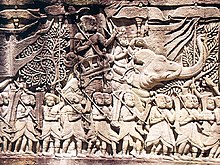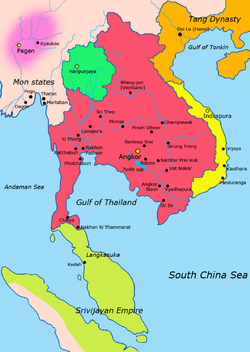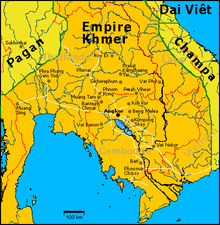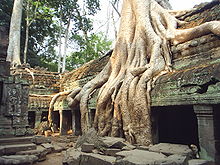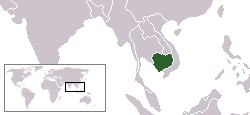有史以前
詳細は「有史以前のカンボジア」を参照
Early history of Cambodia
From Wikipedia, the free encyclopedia
Part of a series on the
History of CambodiaEarly historyDark ages Colonial period Contemporary era |
| Timeline |
| Cambodia portal |
The Early history of Cambodia follows the prehistoric and protohistoric development of Cambodia a country in mainland Southeast Asia. Thanks to archaeological work carried out since 2009 this can now be traced back to the Neolithic period. As excavation sites have become more numerous and modern dating methods are applied, settlement traces of all stages of human civil development from neolithicHunter-gatherer groups to organized preliterate societies are documented in the region.[1][2][3][4]
Historical records of a political structure on territory, what is now modern day Cambodia first appear in Chinese annals in reference to Funan, a polity that encompassed the southernmost part of the Indochinese peninsula during the 1st to 6th centuries. Centered at the lower Mekong,[5] Funan is noted as the oldest regional Hindu culture, which suggests prolonged socio-economic interaction with maritime trading partners of the Indosphere in the west.[6] By the 6th century a civilisation, titled Chenla or Zhenla in Chinese annals, has firmly replaced Funan, as it controlled larger, more undulating areas of Indochina and maintained more than a singular centre of power.[7][8]
The Khmer Empire was established by the early 9th century in a mythical initiation and consecration ceremony to claim political legitimacy by founder Jayavarman II at Mount Kulen (Mount Mahendra) in 802 C.E.[9] A succession of powerful sovereigns, continuing the Hindudevarajacult tradition, reigned over the classical era of Khmer civilisation until the 11th century. A new dynasty of provincial origin introduced Buddhism which leads to royal religious discontinuities and decentralization.[10] The royal chronology ends in the 14th century. Great achievements in administration, and accomplishments in agriculture, architecture, hydrology, logistics, urban planning and the arts are testimony to a creative and progressive civilization - in its complexity a cornerstone of Southeast Asian cultural legacy.[11]

Ancient Khmer script
古代
扶南王国
詳細は「扶南」を参照
中国の書物によると、1世紀ごろ、ほぼ現在のカンボジア南部からベトナム南部のメコン・デルタ地帯に跨る地域に扶南(フナン)という王国があった。1942年フランス人考古学者ルイ・マルレによって、ベトナム南部アンザン省バテ山とその付近の港市跡オケオから、装身具や交易品多数が発掘された。当地の後背地では後期新石器時代から人々が居住していた。プレ・オケオ文化の土器や遺跡がアンザン省ゴーカイトゥン遺跡やロンアン省付近の遺跡から発見されており、そこから西方に拓かれていたカンボジア平原まで人々が居住し、往来があった。
真臘王国
詳細は「真臘」を参照
6世紀には、カンボジア国家の起源とみなされている国、すなわち中国史料にいう北方クメール人による真臘(しんろう、チェンラ)が勃興した。この国は扶南の属国であったが、7世紀には扶南を滅ぼし、さらに真臘王イシャーナヴァルマン1世(611年-635年)に影響を受けた地域がドヴァーラヴァティー王国から独立し、ラヴォー王国がロッブリーに出来た。[1]
真臘王国はジャヤーヴァルマン1世(657年 - 681年)の治世の頃に最大となった。インド文化の影響を受けサンスクリット文字を使用したが、クメール文字も使われ始めた。真臘は、現在のカンボジアとラオス南部、つまりメコン川流域を領土としていたと推測されている。
シャイレーンドラ朝
しかし、ジャヤーヴァルマン1世の死後、古代カンボジアは、中国の記録に見える北の陸真臘(現在のラオスチャンパーサック県)と南の水真臘に分裂し弱体化し、8世紀には水真臘がシャイレーンドラ朝ジャワ王国の支配下に入った。シャイレーンドラは、その意味(「山の王家」)から、扶南のプノン(山)と関係があり、シャイレーンドラ朝とシュリーヴィジャヤ王国は何らかの意味で、扶南の後継者にあたるのではないかとする見方がある。
中世
クメール王朝
詳細は「クメール王朝」を参照
シャイレーンドラ朝からの独立は、ジャヤーヴァルマン2世(802年 - 854年)により行われた。ジャヤーヴァルマン2世はプノン・クレン丘陵の頂上で即位[2]を行い、シャイレーンドラ朝からの解放を宣言した。これがアンコール王朝(クメール王朝)の始まりである。9世紀の末、ヤショーヴァルマン1世(889 - 910年頃)がアンコールに新都城「ヤショーダラプラ」[3](889-1190)を築いた。このときの勢力範囲は、現在の東北タイ地域まで広がっていた。その後何代かの王が続くが、勢力争いや逝去で、どの王朝も長くは続かなかった。
1113年、スールヤヴァルマン2世が即位し、国内各地の敵対勢力と戦い国内を統一、国外においても西方のチャオプラヤー川デルタのシャム人やモン人と戦い、南隣のチャンパ王国や東隣の李朝へ攻め入った。王国の範囲は、タイ中部、マレー半島、ベトナム南部に及び、また、彼は寺院建築にも熱心で、クメール美術の最高傑作であり、自身の墓でもあるアンコール・ワットを始め、トマノン、バンテアイ・サムレ(Banteay Samré)などのヒンドゥー教寺院を建築した。この王の治世も平穏安泰ではなかった。1150年頃死去した。
スールヤヴァルマン2世死後、王位を巡り争いが続いた。さらに1177年には、チャンパ王国の大軍が都であったヤショーダラプラを破壊した。
1181年、チャンパに遠征していたジャヤーヴァルマン7世が帰国し、即位した。彼は粘り強く国づくりを進め、1190年には宿敵チャンパを降伏させた。また、8メートルの高さの堅固な城壁の「輝ける新都城」アンコール・トム(1190-1431)を都として造成した。アンコール王朝の最盛期であった。熱心な大乗仏教の信者であった王は、都の中心にバイヨンを建設し、バンテアイ・クデイ(Banteay Kdei)、1186年にタ・プローム(僧院)、1191年にプリヤ・カーンなどの仏教寺院を建設した。
また、ジャヤーヴァルマン7世は、国内に102箇所の病院と主要街道に宿場を建設し、庶民の生活も重視した。しかし、大規模な寺院建設と領土獲得の遠征のため、死後(1220年)は国力が衰退していったと考えられている。その後、インドラヴァルマン二世、ジャヤーヴァルマン8世(1243-1295)が継いだ。1283年にクビライのモンゴル帝国の軍がアンコール・トムに侵攻した。ジャヤーヴァルマン8世は、1285年と1292年に元朝に朝貢した。この治世に廃仏事件が起こり、ヒンドゥー教に由来する題材に彫り直された。1295年に仏教徒のインドラヴァルマン三世がジャヤーヴァルマン8世を殺害し、王位に就いた。
カンボジアの暗黒時代
詳細は「カンボジアの暗黒時代」を参照
Dark ages of Cambodia
From Wikipedia, the free encyclopedia
| Cambodia | |||||
| |||||
| Capital | Srey Santhor(1431–1434) Chaktomuk(1434–1525) Longvek(1525–1603) Lvea Aem(1603–1620) Oudong(1620–1863) | ||||
| Languages | Old Khmer Sanskrit | ||||
| Religion | Buddhism | ||||
| Government | Absolute monarchy | ||||
| King | |||||
| • | 1431–1463 | Ponhea Yat(first) | |||
| • | 1860–1863 | Norodom(last) | |||
| Historical era | Middle Ages | ||||
| • | Fall of Angkor | 1431 | |||
| • | French Protectorate | 11 August 1863 | |||
| Today part of |  Cambodia Cambodia Thailand Thailand Vietnam Vietnam | ||||
Part of a series on the
History of CambodiaEarly historyDark ages Colonial period Contemporary era |

